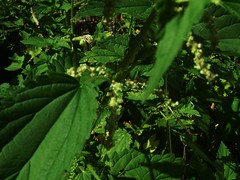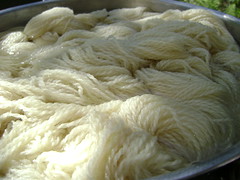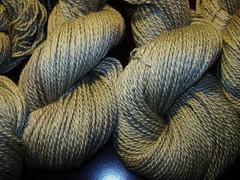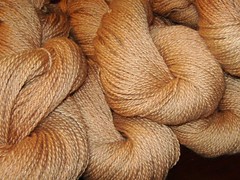A sting like you've never known.....
 Let me introduce you to one of my favorite 'wild' plants - nettle. I've loved nettle for many reasons over the years. Used as a medicinal herb, it is a great 'house cleaner' of the glands/bloodstream - sweeping out the plaques and cruddy glumps and providing a healthy and naturally absorbing form of calcium and iron which are both essential to building a healthy blood supply. Oh, and they make your hair and nails shine and grow as well as making your skin clearer. Used in tea form, obviously.
Let me introduce you to one of my favorite 'wild' plants - nettle. I've loved nettle for many reasons over the years. Used as a medicinal herb, it is a great 'house cleaner' of the glands/bloodstream - sweeping out the plaques and cruddy glumps and providing a healthy and naturally absorbing form of calcium and iron which are both essential to building a healthy blood supply. Oh, and they make your hair and nails shine and grow as well as making your skin clearer. Used in tea form, obviously.
I mean, should you ever just be meandering along and stumble upon a nettle, you will surely know that THAT experience does no real benefit to the skin. Personally, I think that's why it boasts those pretty little sprays of baby's breath-like flowers - to sort of taunt you into walking over to it and, just before you grasp it, saying something in your native southern twang like, "oh gosh, look at these pretty little blosso-aaacckkk!(insert sounds of gurgling, cursing, and generally pretending to be on the last minute of your dying day as you squirm neath the fiery sensations and creeping, swelling welts popping up here and there)". It has added effect if there is someone (and I hope, for your sake, that it is NOT your smarty pants husband)watching you stroll across the yard to take a closer look. Trust me, you will only do it once before you will commit to memory that this little powerhouse plant, with it's seductive flower sprays, is only fit to admire with a GLOVED HAND.
To dye with nettles, the best time to pick them is also when they are at their 'peak' of potency - when those little flower sprays are all over it and dancing daintily in the breeze. See the stems on the right - all those little hairy thorns all down them? Gloves! Don't ever forget. Pick enough to fill your stockpot - packing them down as you go. Then, pour water to nearly full and boil for about 1/2 hour. Remove from heat and let set for a few hours or, even better, a whole day. The brew will get darker and stronger. If you want an 'olive' sort of green, add about 4-5 tablets of ferrous sulphate (iron). I just use the vitamin form that you can cheaply buy at a pharmacy. Put those in after you've boiled the tea and let them dissolve as the tea cools and strengthens its color. In the meantime, you'll want to prepare your skeins to be dyed. I started with this magnificent yarn that Deb at the Stonehedge Fiber Mill spun up for us. It was primarily cotswold with some mixed breed (targhee, corriedale, etc) mixed in and a slight bit of pure tussah silk pindrafted along with it - ensuring the most lustrous, soft, gorgeous yarn. I can't say enough about this mill - they just did such a beautiful job. I took 5 of the dk wgt. skeins and simmered them for 1 hr in an alum/cream of tarter mordant bath. Then, I hung them up to wait for their lovely nettle tea.
In the meantime, you'll want to prepare your skeins to be dyed. I started with this magnificent yarn that Deb at the Stonehedge Fiber Mill spun up for us. It was primarily cotswold with some mixed breed (targhee, corriedale, etc) mixed in and a slight bit of pure tussah silk pindrafted along with it - ensuring the most lustrous, soft, gorgeous yarn. I can't say enough about this mill - they just did such a beautiful job. I took 5 of the dk wgt. skeins and simmered them for 1 hr in an alum/cream of tarter mordant bath. Then, I hung them up to wait for their lovely nettle tea.  After the tea darkened significantly, I strained all the plant matter out and put the yarn in the tea on low heat to simmer for another hour. This plant takes very little rinsing to remove any excess dye and the result is fairly washfast and lightfast. I love the cool, sagey, minty tone!
After the tea darkened significantly, I strained all the plant matter out and put the yarn in the tea on low heat to simmer for another hour. This plant takes very little rinsing to remove any excess dye and the result is fairly washfast and lightfast. I love the cool, sagey, minty tone!
If you've been reading the blog for long, you probably already know how I feel about 'natural' dyes. I generally only like to dye with native plants that are in abundance. The following, a madder concentration, would be a good example as to why. Cost is a consideration for sure. Nettle grows rampant as opposed to the madder which cost me about 3.00 per skein in dye matter alone. You add that, plus the fact that the natural dyes consume 4-6 times more water to process, fuel for processing, and added amendments to get accurate color, and the base fiber (which, in this case was to house, feed, shear, and have spun the wool) and it is difficult to dye in this manner but for one's own pleasure and use. Also, there is the whole 'natural' hang up that I have. See, to me, natural should mean honoring if not assuring no harm done to, well, nature. Chrome, copper, sulfates, and other additives are quite dangerous to use and can have lasting effects on the planet. So, I will only dye with the basic alum and cream of tarter. Anything that requires the heavy metals to bring color is not something I care to do. In that case, I prefer my acid dyes. Non-toxic pigment activated by household vinegar which, when neutralized with baking soda being added to the exhausted bath water, is fairly safe and leaves little lasting print on Nature.
Also, there is the whole 'natural' hang up that I have. See, to me, natural should mean honoring if not assuring no harm done to, well, nature. Chrome, copper, sulfates, and other additives are quite dangerous to use and can have lasting effects on the planet. So, I will only dye with the basic alum and cream of tarter. Anything that requires the heavy metals to bring color is not something I care to do. In that case, I prefer my acid dyes. Non-toxic pigment activated by household vinegar which, when neutralized with baking soda being added to the exhausted bath water, is fairly safe and leaves little lasting print on Nature.
Though madder is costly, as it is not native to our region, it is relatively harmless to use. I began with the roots - added to 2 gallons of water and boiled for one hour. Then, again, left to sit for 4-24 hrs. to 'strengthen' the tea. Strain the root matter out and add the mordanted skeins to the tea, simmering for one hour. Let the yarn cool in the tea. Rinse in hot water with some vinegar to 'set' the color, rinse again until clear, and you have a lovely golden peach. Some texts will say you can get red - and you can. Only, the $12.00 of madder root would have only dyed two skeins instead of 6. Uhm, that is a very expensive way to dye and the deeper the color, the more likely it is to bleed over time anyway. I've settled on using madder for this lovely melon color and will, again, use the acid dyes for a deep red. You can always try cochineal for red, and we will next time, but the red is very 'purpley' red. Cochineal is also a low-chemical natural dye method but you have to be cruel enough to grind up all those poor dead bugs (they are dead already and dried but still, if you're sentimental like me, it can be a burden) and it bleeds like crazy so you have to rinse it a billionty times to get the the 'final' color tone. It is so taxxing that it deserves a day of its own on the blog, doncha think?


|